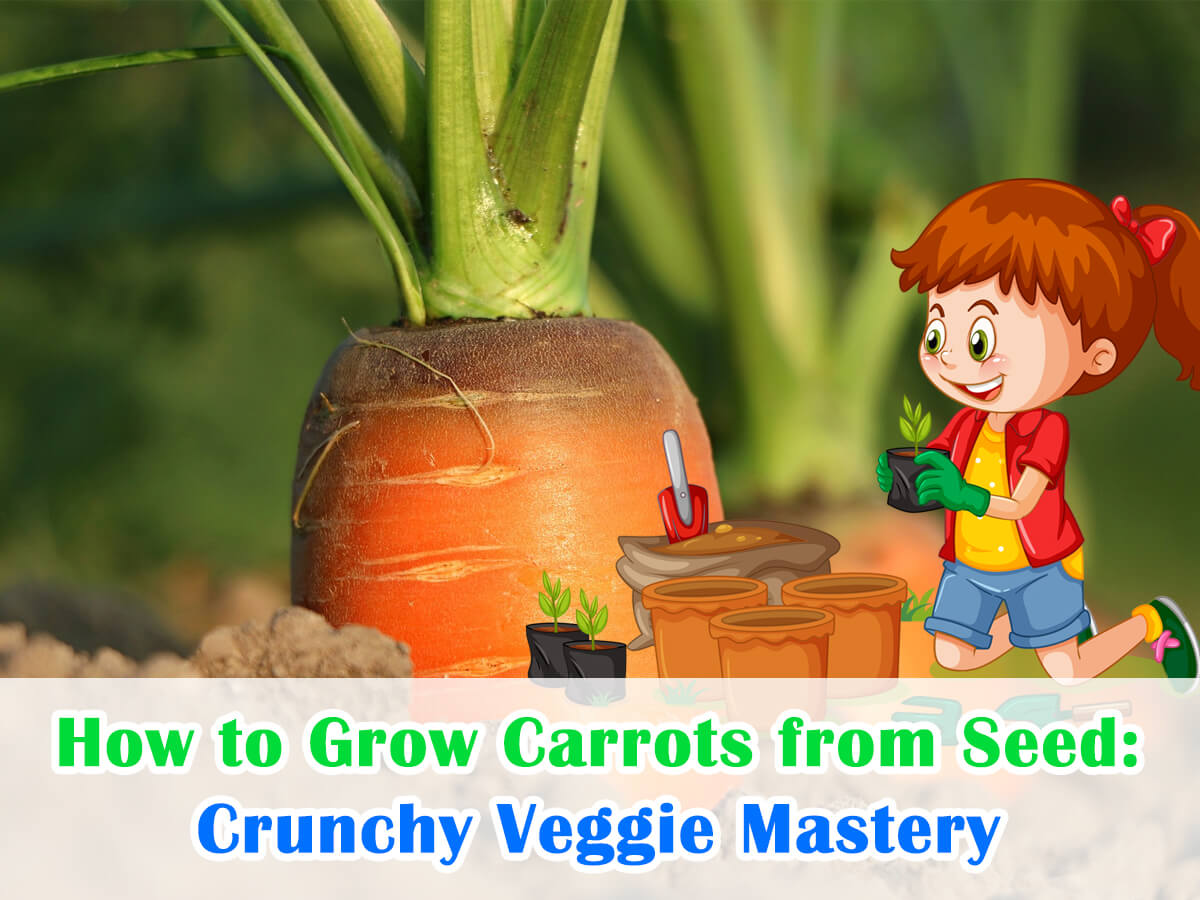I still remember the day I bit into my first homegrown carrot, freshly pulled from the earth, and experienced its sweet, earthy flavor that far surpassed any store-bought carrot I had ever tasted. From that moment, I was hooked on growing my own carrots, and it became my mission to cultivate the perfect carrot patch. Over the years, I’ve learned a thing or two about how to grow carrots from seed, and now I’m excited to share my discoveries with you.
In this article, we’ll embark on a carrot-growing adventure together, exploring each step of the process from seed to harvest. So grab your gardening gloves, and let’s dive in!
1. Choose the Right Carrot Seeds
One of the first things I realized when I started growing carrots was that there are so many varieties to choose from! From the classic orange Nantes to the vibrant purple Cosmic, there’s a carrot variety to suit every gardener’s taste.
Take the time to choose a variety that suits your taste and growing conditions, as this will greatly influence the success of your carrot garden. Personally, I recommend looking for seeds that are labeled as “heirloom” or “open-pollinated,” as these will produce true-to-type plants and can be saved for future planting.
From my experience, I highly recommend the Danvers Half Long Carrot Seeds. These non-GMO, heirloom seeds produce delicious, bright orange carrots with a classic, slightly tapered shape. What I love about the Danvers variety is its adaptability to various soil types, including heavier soils. This makes it an excellent choice for gardeners who may not have the ideal soil conditions for growing carrots.
The carrots reach a length of 6-8 inches and boast a sweet, tender taste with a satisfying crunch. The seeds come in a water-resistant packet with detailed planting instructions, making it easy for both beginner and experienced gardeners to succeed. Click here to read more information on these carrot seeds.
2. Prepare the Soil
Carrots prefer loose, well-draining soil that is free of rocks and debris. I learned this the hard way when I tried to grow carrots in my compacted, clay-heavy garden bed. The result? Short, stubby carrots that were far from the picture-perfect specimens I had hoped for.
To avoid this, loosen the soil to a depth of at least 12 inches and incorporate plenty of organic matter, such as compost or well-rotted manure. This will not only improve the soil structure but also provide essential nutrients for your growing carrots.
To guarantee that your carrots grow to their full potential, use a vegetable garden soil such as Miracle-Gro Garden Soil All Purpose. This 1 cu. ft. bag is perfect for in-ground use and provides essential nutrients for all of your plants and vegetables, including carrots. With its 3-month feeding formula, your carrot will receive continuous nourishment, promoting healthier growth and more bountiful yields. It’s a highly rated item on Amazon, with over 1,100 positive reviews that you can read here.
3. Sow the Seeds
When it comes to sowing carrot seeds, patience is key. I remember the first time I planted carrots, I was so eager to see them sprout that I sowed the seeds too thickly, resulting in overcrowded seedlings.
Carrot seeds are tiny, so it’s important to sow them thinly, about 1-2 inches apart, in rows that are spaced 12-18 inches apart. This will give your carrots ample room to grow and make thinning much easier later on. Cover the seeds with a light layer of soil and water gently to avoid dislodging them.
4. Take Care of Your Carrot Seedlings
Once your carrot seeds have germinated (which can take anywhere from 1 to 3 weeks), it’s important to keep the soil consistently moist. Carrots are sensitive to drought, so I always make sure to water my seedlings regularly, especially during dry spells. To minimize the risk of diseases, water at the base of the plants and avoid wetting the foliage.
As your seedlings grow, you might need to thin them out to prevent overcrowding. It was difficult for me to thin my first crop of carrots, as I hated the idea of sacrificing any of my precious seedlings. But I soon realized that thinning is essential for the development of healthy, well-formed carrots. Aim to thin your seedlings to about 2-4 inches apart, depending on the variety.
5. Constantly Perform Pest Control and Maintenance
One of the most crucial aspects of growing carrots is effective pest control and regular maintenance. Carrots can fall victim to a variety of pests, with the carrot fly being one of the most notorious. These pesky insects lay their eggs at the base of the carrot plants, and their larvae feed on the roots, causing severe damage and sometimes rendering the carrots inedible.
To protect my carrots, I’ve found that companion planting with strong-smelling herbs like chives, rosemary, or sage can help deter carrot flies. Additionally, using floating row covers is another effective method to keep these insects at bay.
Another common pest that can affect your carrot plants is the aphid. These tiny, sap-sucking insects can cause leaves to curl, wilt, or turn yellow and may even transmit plant diseases.
To control aphids, regularly inspect your plants for signs of infestation, and take action as necessary. You can remove them by hand, use a strong spray of water to dislodge them, or introduce beneficial insects like ladybugs that naturally prey on aphids. If the infestation is severe, consider using organic insecticides such as insecticidal soap or neem oil.
6. Maintain Heatlhy Growing Environment
Apart from pest control, maintaining a healthy growing environment for your carrots is vital. Regularly weed the area around your plants to prevent competition for nutrients and water. Mulching the soil surface with organic material like straw or compost can help retain moisture, suppress weeds, and regulate soil temperature.
Additionally, keep an eye on your plants for any signs of diseases, such as leaf spots or wilting. If you notice any symptoms, promptly remove the affected plant parts to prevent the disease from spreading, and ensure proper sanitation of your gardening tools.
By staying proactive with pest control and maintenance, you can keep your carrot patch healthy and productive throughout the growing season. Naturally, this applies to any plant that can be grown from seed.
Here are a few more tips from GrowVeg on growing carrots from seeds:
https://www.youtube.com/watch?v=jvn_HHIB6tM&ab_channel=GrowVeg
7. Harvest Your Carrots
One of the most rewarding moments in my gardening journey was when I pulled my first homegrown carrot from the soil. It felt like a small miracle, and I couldn’t wait to taste the fruits of my labor!
Carrots can be harvested once they reach their desired size, which will depend on the variety you’ve chosen. Generally, carrots are ready to harvest around 60-80 days after planting, but you can always check their progress by gently brushing away the soil around the top of the carrot to reveal its size.
To harvest your carrots, gently grasp the foliage near the base and pull upwards, taking care not to break the carrot in the process. If the soil is compacted, you may need to use a garden fork to help loosen it before pulling the carrots. Once harvested, remove the foliage and gently brush off any excess soil. This will help prevent the carrots from rotting in storage.
8. Store the Carrot Harvest
Properly storing your carrot harvest will ensure that you can enjoy their fresh, earthy flavor long after the growing season has ended. After harvesting, allow your carrots to dry for a few hours in a well-ventilated area. This will help reduce the moisture content and minimize the risk of rot during storage.
Once dry, place your carrots in a container filled with slightly damp sand or peat moss, making sure that the carrots do not touch one another. Store the container in a cool, dark place, such as a basement or garage. Check on your stored carrots periodically to ensure that they remain in good condition and remove any that show signs of spoilage.
You can also store your carrots in the refrigerator for shorter-term use. First, remove any remaining foliage and gently clean off excess soil from the carrots. Then, wrap them in a damp paper towel or cloth and place them in a perforated plastic bag to allow for air circulation. Store the bag in the crisper drawer of your refrigerator, where the humidity is higher.
Carrots stored in the fridge can typically last for 3 to 4 weeks before their quality begins to decline. Check on them regularly and remove any carrots that show signs of spoilage to prevent the spread of rot to the remaining carrots.
In Conclusion
Growing carrots from seed can be a rewarding and satisfying experience, providing you with a bountiful harvest of delicious, homegrown produce. By following the steps outlined in this article and incorporating your own personal anecdotes and experiences, you’ll soon discover the joy of growing your own carrots.
Remember, gardening is a learning process, so don’t be afraid to experiment and try new techniques as you cultivate your personal garden.
Happy gardening!



